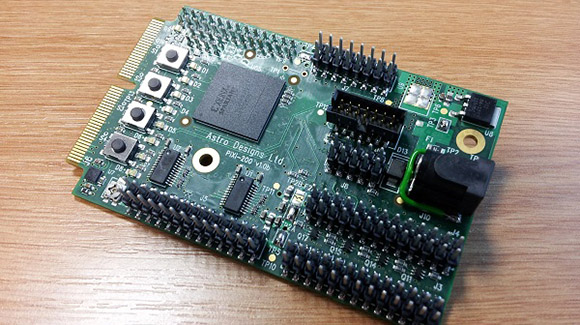
A few years ago the folks at Astro Designs put together a board that took off-the-shelf CCD sensors from point and shoot cameras and turned them into respectable astrophotography sensors. Since then, the world has seen an explosion of Raspberry Pis, Arduinos, and other microcontroller platforms, making this the perfect time for a hardware revision.
Their PiXi-200, like their previous AstroCam board, is able to take image sensors out of cameras and turn them into telescope mounted cameras. That’s only one of its tricks, though: The PiXi-200 also has accelerometers, gyroscopes, enough UARTs to do just about anything, a four channel ADC and four channel DAC, two dozen GPIO pins, enough LEDs and buttons for any project, and a 200,000 gate FPGA. All this in a board that plugs directly into the GPIO pins on the Raspberry Pi just like an Arduino shield. Needless to say, there’s a lot you can do with this board.
Right now, the design is still in the prototype stage, but once everything is finalized the basic model of the board will sell for £30 GBP ($50 USD). The high-end “Model C” board, with all the bells and whistles, will sell for £45 GPB ($70 USD).















Somewhat better photo (and blog to keep an eye on) here:
http://rasathus.blogspot.be/2013/01/a-sneaky-peak-at-pixi-200-expansion.html
Could someone elaborate on how they “take image sensors out of cameras and turn them into telescope mounted cameras”?
I think it went as far as providing motion control and the ability to export an image from the CCD, rather than the mounting itself.
apart from the obvious mechanical issues, it is favorable to cool the sensor down to -20..-80°C. This drastically reduces the dark current and permits extreme exposure times. Several minutes of exposure are not uncommon.
Definitely interested in that last part about harvested CCDs as well. Unfortunately neither the linked website nor the blog go into details or show that it was done before. I’m tinkering with consumer cams myself and documentation on those chips (and displays btw) is very thin.
I don’t see a gyroscope on the linked page, both Justin’s link and the story show a magnetometer instead.
Still, pretty decent as an add on board for £30. That high speed LVDS on the card edge might really improve the RasPi’s IO capabilitesd, but I wonder how fast the link between the RasPi and the board is through those GPIO headers..
The communication between the Raspberry Pi and the FPGA takes place over either SPI or i2c, at the moment I’ve been using SPI. There isn’t a great deal that can be done about the I/O limitations of the Pi, but the card edge connector does mean you can get data onto the FPGA quickly, do your processing there, and pass your resultant data down to the Raspberry Pi.
You know a version for the Beagle Bone could be useful as well. I know the Pi is getting all the buzz because of the low cost but the Bone is a good alternative. That is if you have the time and or resources.
They need to ad gyros for sure. Other than that wow.
Out of curiosity, why do you need gyros for astro photography?
so you can do precise motion control of the telescope.
That may be why they didn’t. You can add a gyro through the gpio, but if its on the board then you have to mount the board on the scope to measure rather than just the tiny gyro. I suspect it makes it easier to do that if it doesn’t add as much weight to the scope and it’d greasier to mount something small to the right place.
Greasier == be easier…. autocorrect
Robots, mmmmmm.
What kind of camera, would you use, and how would it attach to this board, for astrophotography? I imagine that attaching a camera to an RPi would make a much more portable rig than carrying a laptop, maybe letting you auto-guide and do image acquisition on the small computer that is the RPi. But I’m not seeing how this board fits in with that. Does this record orientation of the camera over an imaging session and tag the images with it? Does this connect to some de-rotator so you can use Alt-Az? Does it to image processing to handle dark subtraction automatically?
That being said, lots of fast IO, and an FPGA programmable from the RPi has tons of potential as a general purpose RPi add on.
Very interested in this – I’ve currently got an arduino talking to my mount’s GotoStar (GotoNova) motors, but it just doesn’t have enough grunt to drive a display too. Seems like this board + RPi would be perfect.
>Their PiXi-200, like their previous AstroCam board,
googled for AstroCam, couldnt find it ever existing
also couldnt find a list of those CCDs and sources of them
Is anything happening with the project, it seems to have stalled?/died?